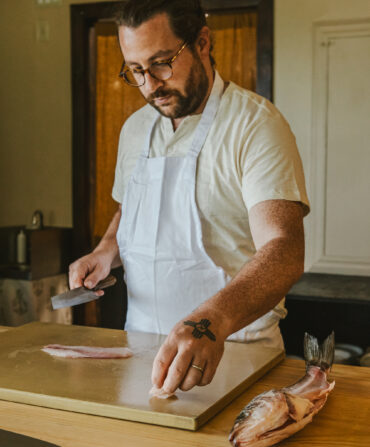Kevin Mitchell of Charleston, South Carolina, loves the black-eyed pea. “It’s the first one my grandmother taught me to cook, and I’ve always been partial to it,” says the Culinary Institute of Charleston instructor, who prepared some twenty varieties of cowpea for a tasting in his hometown last weekend. Not everyone is quite so fond of it, though.

Photo: Ross Spears
A plate of crowder peas.
David Shields of the University of South Carolina, for example. “Southerners in the nineteenth century used the black-eyed pea as cattle fodder,” he says. “It’s the chalkiest pea, and it has the dullest, most unengaging flavor of any pea out there. A lot of the reputation that cowpeas have now is because people were eating black-eyes.”
Didn’t think people could get so worked up about peas?
They were the center of attention this past weekend for dozens of chefs, academics, and growers from all over the country, who sampled some twenty different types of cowpea at a gathering meant to shine a light on the often overlooked staple crop.
As a few speakers explained, it was an event with historical and agricultural precedents. George Washington Carver studied cowpeas as well as peanuts, and this tasting was a continuation of his research, inspiring talk about pickling immature pods and crafting bean-based desserts. After tasting the peas with cocktails and cornbread, attendees voted for the types most likely to make it onto menus and into saucepans in the years to come.
These were the winners, voted best in five established categories of flavor and texture.
Black-eye
Pinkeye Purple Hull: Southerners love this variety, and so did the crowd at the tasting. Not only did this soft, sweet legume win its category, but it also took the overall prize. “When I think about how field peas taste, this is what I think about,” one attendee said.
Crowder
Brown Crowder: “It’s the biggest pea, and it’s the meatiest pea,” Shields says. “It’s not as complicated in flavor as some of the other peas, but it mixes well with other things. It’s great in a pea salad, a pea stew, or rice and peas. It’s the universal donor pea, really.”
Cream
Lady: If you like mashed potatoes, you’ll probably like this soft, inoffensive cream pea. “In the nineteenth century they would have called it farinaceous, or bready,” Shields says.
Field
Petite Rouge: This hardy pea is particularly water-tolerant, a trait that came in handy during the floods that soaked the coast a month ago. Tasting notes: meaty, dark, earthy. “These cooked up really well, and they gave us a thick, red potlikker,” Mitchell says.
Rice
Tresimino White: It’s sturdy, buttery, and popular in Italy—maybe because it tastes and feels a lot like pasta. “If you like orzo, you’ll love it,” Shields says. “You can sauce it.”







